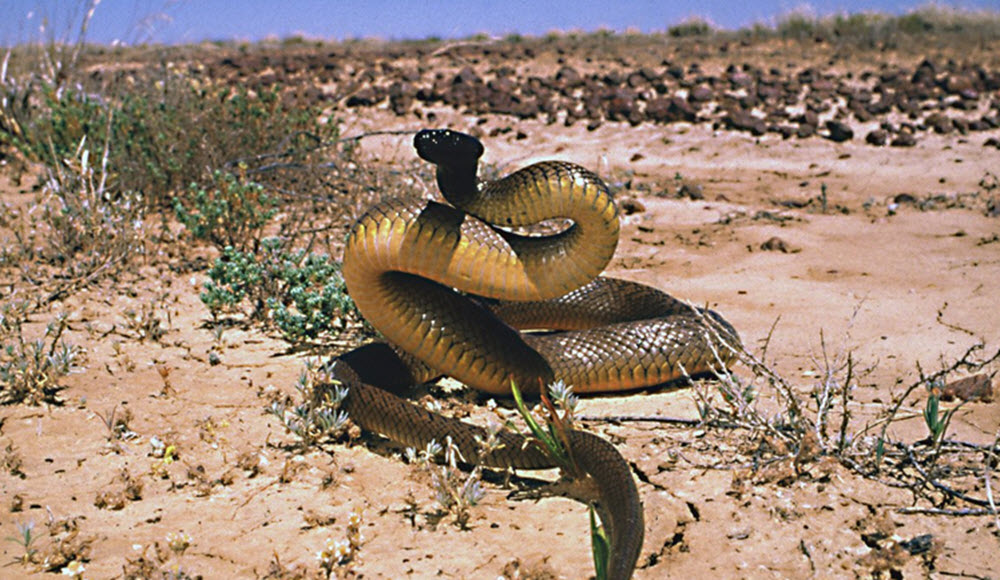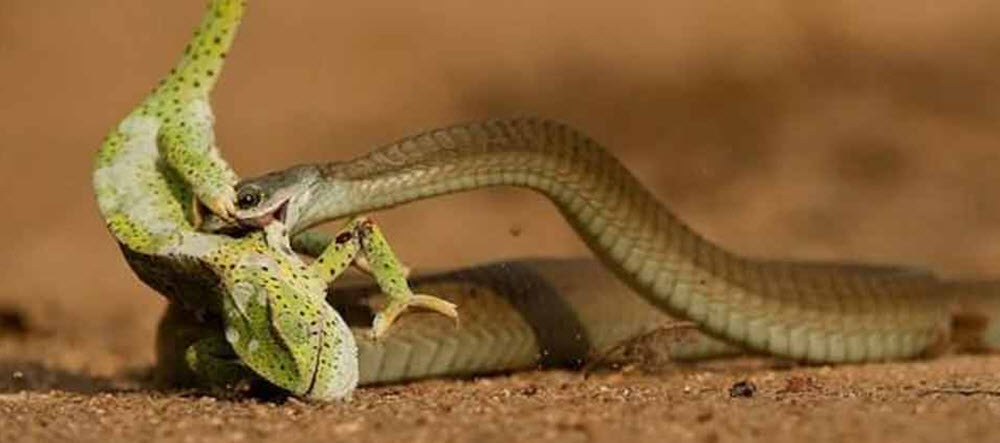Inland taipan

With a murine LD 50 value of 0.025 mg/kg subcutaneous for mice, the Inland taipan (Oxyuranus microlepidotus) produces one of the strongest venoms of all snakes. Based on studies done on mice, it is – drop for drop – the most toxic venom produced by any snake, even stronger than sea snake venom. It is also the most toxic of any reptile venom tested on human heart cell culture.
In a single bite, the Inland taipan can deliver enough venom to kill at least 100 adult men. Death can occur quickly after a bite, sometimes wihtin 30-45 minutes without treatment.
Fortunatelly, it is very unusual for humans to be bitten by Inland taipans. This is due to several reason:
- The Inland taipan inhabits remote areas of Australia that are sparsely populated.
- The Inland taipan likes to hide below ground during the day.
- The Inland taipan is comparatively shy and reclusive.
- The Inland taipan is not very bothered by human presence, unless you threaten it. The Coastal taipan (Oxyuranus scutellatus) is considerably more aggressive than its inland relative. Most reported cases of Inland taipan snake bites occured when someone was handling the snake, trying to corner it or preventing it from escaping.
- The Inland taipan will typically try to scare you away first instead of biting you, and most people who aren’t professional snake handlers will happily take this opportunity to leave. The snake will raise its forebody in a tight low S-shaped curve, with its head facing you, and this means that it is bothered by your presence and that you should leave immediately.
Leaving this snake alone is strongly recommended, because if it wants to strike it is very likely to succeed, since it is extremely fast and agile. It can strike with extreme accuracy and (unlike some other venomous snakes) it will almost always inject venom into the bite wound instead of just biting you.
Contents
Scientific classification
| Kingdom: | Animalia |
| Phylum: | Chordata |
| Class: | Reptilia |
| Order: | Squamata |
| Suborder: | Serpentes |
| Family: | Elapidae |
| Genus: | Oxyuranus |
| Species: | Oxyuranus microlepidotus |
Conservation
The Inland taipan is listed as Least Concern by IUCN 3.1.
Like all other native Australian snakes, it is protected by law in Australia.
Where does this snake live?
The Inland taipan lives on the semi-arid black-soil plains where the border regions of Queensland and South Australia converge.

What does the Inland taipan eat?
The Inland taipan hunts and eats mammals. It’s venom is especially adapted for killing warm-blooded animals.
The bulk of its diet consists of rodents, both native species such as the long-haired rat and introduces species such as the house mouse. It also hunts suitably sized dasyurids, a family of marsupial species native to this part of the world.
When hunting, the Inland taipan attacks its victim with a series of rapid strikes. Up to eight venomous bites in a single attack is not unusual. The snake may hold the prey with its body while injecting venom deep into the body of the unfortunate animal. The venom acts very quickly.
More info about the venom
- The average quantity of venom delivered by an Inland taipan is 44 mg. The maximum recorded dose was 110 mg.
- The Inland taipan has a smaller venom yeild than the Coastal taipan, but the venom is nearly four times as toxic.
- The biological properties and toxicity of the venom is roughly the same for baby and adult Indland taipans.
- The Inland taipan venom is a mixture of various toxins, including several neurotoxins (that affects the nervous system), procoagulant hemotoxins (that increases the blood’s ability to form clots), and myotoxins (that affects the muscles). As if this wasn’t enough, there is also the hyaluronidase enzyme which increases the body’s absorption of the toxins.
- One of the toxins delivered in the toxin-cocktail is paradoxin (PDX), which is one of the most potent beta-neurotoxins known to science. It will prevent the nerve endings from releasing acetylcholine, a very important neurotransmittor.
Is there an antivenom?
The CSL Ltd Taipan antivenom is effective against both Coastal and Inland taipan bites, although it is more effective against Costal bites than Inland bites. Yet, in all reported cases of Inland taipan bites where antivenom as been administered fairly soon after the snake bite, the patient has survived. Even with the prompt administration of antivenom, however, the recovery time can be long and difficult.
In cases where the snake species remains unknown or unclear, an Australian polyvalent (broad spectrum) antivenom can be administered instead.
The CSL Ltd Taipan antivenom is manufactured by the Australian Reptile Park and the Commonwealth Serum Laboratories in Melbourne.
Important: The venom of the Inland taipan snake contains both pre-synaptic and post-synaptic neurotoxins. The pre-synaptic toxin disrupts the release of the neurotransmitter from the axon terminal, while the post-synaptic toxin block the receptor. The post-synaptic toxins in the venom act very quickly, but are less potent and do respond well to antivenom treatment. The pre-synaptic toxins work slower, but do not respond to antivenom treatment and can take days to resolve.